|
CHAPTER VIII
MAN'S FIRST RELIGION
Among the most interesting of questions are: How did man first learn
religion? and what was the form of this religion? Ancient history
supplies the information.
The minds of primitive man, generally, were in such an uncultured
state that they could not be brought to understand the meaning of
such words, for instance, as "infinite," "everlasting," "almighty"
without some special form of teaching. To enable man to grasp such
meanings he was first taught that there was a Deity and a heaven
hereafter: that he had an everlasting soul which did not die: that
the Deity had many attributes and was all-powerful and everlasting.
Then symbols such as primitive man could understand were selected to
represent the Deity and each of His attributes, and heaven. Thus was
laid the foundation of the many pantheons, with their various
symbolic meanings, that have crept into all religions down to, and
including, the modern Christian religion.
The most primitive forms of symbols were lines and simple
geometrical figures. At first these symbols were few in number, but
as time went on the number increased, also their intricacy, until we
reach the period of the Egyptians, when they had become so numerous
and complex that not half the Egyptian priesthood understood them
all.
Hermes Trismegistus in his writings said:
"Oh Egypt! Egypt! of all
thy religion, fables only will remain which thy disciples will
understand as little as they do thy religion. Words cut into stone
alone will remain telling of thy pious deeds. The Sythians, or the
dwellers by the Indus, or some other barbarians will inhabit thy
fair land."
Moses fathered the doctrine of monotheism, as an outgrowth of the
Osirian religion, yet he continued the use of many of the original
symbols in his teachings. In fact some of these symbols are to be
viewed today in Jewish synagogues.
Christ's teachings were always in parables. He distinctly declared
that He preached in parables because it was the only way the people
could be brought to understand. Parables are phraseological symbols.
Max Muller writes:
"As soon as we know aught of the thoughts and
feelings of primitive man, we find him in possession of a religion,
a religion of faith or worship, of morality or ecstatic vision: a
religion of fear and hope, or of surmise, or reverence of the Great
God through various symbols."
When primitive man used a symbol it did not mean to him the object
in sight, but what it represented in his mind.
This primitive and ancient custom remains dear to us: we still use
symbols, as, for instance, the cross symbolizing Christ.
The symbols on the walls of the Temple of Sacred Mysteries at Uxmal,
Yucatan, are most valuable as applying to this work, as an
inscription on the temple walls tells us that they came from the
fountain head - the Lands of the West, the Motherland of Man.
Therefore, we may safely assume that the symbols are duplicates of
the symbols first ased in the religious teachings of man, a
statement that is further confirmed by the fact that many of them
are carved on the stones of the South Sea Island ruins.
These
symbols connect mankind throughout the world with the Motherland of
Man - "That Land of Kui" - Mu.
As before stated, among the fallen ruins on some of the South Sea
Islands are numerous symbols of this sort. I have no doubt that if
the walls were still standing intact all would be adorned with such
symbols, as these temples and ruins were within man's first earthly
domain.
It must be fully appreciated by the reader that the complex
cosmogonic figures could only have come into existence after man's
mind had been sufficiently educated to understand them. Probably
thousands upon thousands of years elapsed between the time when
primitive man was first taught that the circle represented infinity
and the time when the intricate and complex cosmogonic diagrams were
intelligible to his more enlightened mind. Thus we find that tens of
thousands of years ago man was so advanced intellectually he could
master these intricate symbolic problems.
The wide scope of these symbols and their common meanings prove them
to have been of common origin. Records in Yucatan show that they
came from the Land of Mu. Egyptian records show that they originated
in the Lands of the West, and Hindu and other Oriental countries
that they came from the Motherland in the East.
Therefore, I think I have established clearly in the mind of the
reader this one dominant fact:
The Land of Mu, the Lands of the
West, that Land of Kui and the Biblical Garden of Eden are one and
the same.
In this chapter I am showing many of the ancient Sacred Symbols,
giving their origin and original meanings. These are of particular
interest to
Freemasons as they not only reveal the origin of
Freemasonry but also its great antiquity.
Hitherto the origin of this brotherhood has never been known; it has
been traced back in Egypt to a time about 5000 B.C. But the question
as to where the Egyptians got it has never been answered. This is a
page in the history of religion that has never been read. This
chapter will turn the leaf.
It has been generally thought that Freemasonry originated in Egypt,
and that the symbols used in their ceremonies are of Egyptian
origin. This is an error; we must go back tens of thousands of years
before the foot of man trod the soil of Egypt to come at the origin
of what today is called Freemasonry.
The Sacred Writings of the Motherland which were carried by the
Naacals (Holy Brothers) to Mu's colonies throughout the world 70,000
years or more ago, if we can depend on the accuracy of the movements
of celestial bodies, is the oldest written information about the
origin of Freemasonry. The extreme age of this brotherhood is not
only attested to by the Sacred Writings but by various Oriental
writings, inscriptions and prehistoric temples, and convincingly
confirmed by Niven's Mexican Stone Tablets which are, as shown by
some of them, over 12,000 years old.
From the foregoing mass of records, it is shown without the
possibility of controversy that our present-day Freemasonry is the
fragments of man's first religious teachings - man's first
expression of his worship and adoration of the Heavenly Father.
The basis of this religion was The Love and adoration of the Creator
as the Heavenly Father, and Love for all mankind as brothers.
Man's first religion was the simplest in form, and the purest form
of worship of the Great Infinite that has ever been taught and
followed on this earth.
It was a monotheistic religion, as only one Creator or Deity was
worshiped, to which they gave many attributes, each attribute having
a symbol assigned to it. At the same time the greatest precaution
was apparently taken to prevent the impression that there was more
than one Creator or Deity; for in all ceremonies the symbol Lahun
(see page 43) is conspicuously embodied.
Lahun translated is "Both
in One" - "All in One."
Fundamentally there is no difference between the ancient and the
present-day conception of the Deity.
The ancients gave Him many attributes, mentioning them singly: we
also give Him many attributes but group them by saying "Everything
comes from God." So, virtually, it is only a difference in
phraseology.
These remnants of man's first religion have been handed down orally
from generation to generation for about 12,000 years, since the time
of the submersion of the Motherland. These scraps have been
correctly and faithfully passed on by those who have preceded us.
One passage in the Sacred Writings I wish particularly to call to
the attention of Master Masons.
It reads:
"To man, the Creator is
incomprehensible, being incomprehensible, He can neither be pictured
nor named - He is the Nameless."
This passage is taken from the Naga Copy.
Lao Tzu. 604 B.C.:
"The Tao that can be expressed in words is not
the eternal Tao. The name which can be uttered is not His eternal
name. Without a name He is the beginning of heaven and earth.
Ceaseless in action He cannot be named. He is the Nameless."
In the ancient hieratic numeral writings the number 10 was assigned
to the Creator. This number was never spoken or written, it was
considered sacrilegious to speak, write or carve the numeral 10.
When it became necessary to use the number the glyph Lahun (see page
43) was given in its place.
The Circle
Fig. 1a. The circle was one of the first three symbols used in man's
religious teachings. It was looked upon as the most sacred of all
symbols. It was a picture of the Sun, called Ra, and was the
monotheistic or collective symbol of all the attributes of the
Deity. The sun, as Ra, was looked upon as the symbol only and in no
way the Deity Himself. The Deity was worshiped, and the symbol used
only to represent Him.
The Deity was treated with such reverence that His name was never
spoken. The Mayas, Hindus, Uighurs and all other ancients spoke of
the Deity as The Nameless. The circle has no beginning nor has it an
end. What more perfect symbol could have been devised or selected to
teach an uncultured mind the meaning of infinity and everlasting?
Evidently the reason for selecting the Sun as the emblem of the
Deity was because it was the most powerful object that came within
the sight and reasoning power of primitive man. It well represented
the All-Powerful.
The Sun is found depicted on the stones of Polynesian ruins, on the
walls of the Temple of Sacred Mysteries, in Egypt, Babylonia, Peru
and all ancient lands and countries - it was a universal symbol.
Fig. 1b. In all the Egyptian symbols representing the Deity, the
heads are crowned with a disk - a picture of the Sun as Ra.
Fig. 1c. A red sphere was occasionally used to cap pillars and the
heads of statues erected to the memory of departed ones.
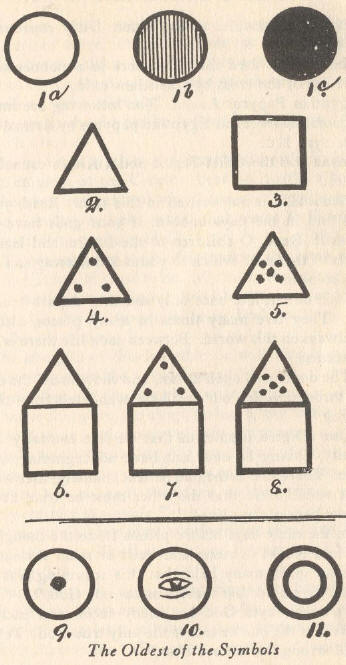
The red spheres found on the heads of Easter Island
The red spheres found on the heads of Easter Island statuary are
examples of the latter. They represent the Sun as Ra.
The ancients used the red sphere in a manner similar to the use of
the cross by Christians today.
Egyptian Papyrus Anana
The following are interesting quotations
from an Egyptian papyrus by Anana, dated about 1320 B.C.
Anana was the Chief Scribe and a King's councilor to Seti II.
"Behold! Is it not written in this roll? Read, ye who shall find in
the days unborn, if your gods have given you skill. Read, O children
of the future, and learn the secrets of that past, which to you is
so far away and yet in truth so near."
"Men do not live once only and then depart hence for ever. They live
many times in many places, although not always on this world.
Between each life there is a veil of darkness."
"The doors will open at last, and show us all the chambers through
which our feet have wandered from the beginning."
"Our religion teaches us that we live eternally. Now eternity,
having no end, can have no beginning, it is a circle. Therefore if
the one be true, namely, that we live on, it would seem that the
other must be true, namely, that we have always lived."
"In the early days before priests froze the thoughts of man into
blocks of stone and built of them shrines to a thousand gods, many
held that this reasoning was true, as then they held that there was
but one God."
"To men's eyes God has many faces, and each one swears that the one
he sees is the only true God. Yet they are all wrong, for all are
true."
"Our Kas, which are our secret selves, show them to us in various
ways. Drawing from the infinite well of wisdom that is hidden in the
being of every man, give us glimpses of the truth, as they give us
who are instructed - power to work marvels."
"The spirit should not be judged by the body, or the god by his
house."
"Among the Egyptians the Scarabeus beetle is no god, but an emblem
of the Creator, because it rolls a ball of mud between its feet and
sets therein its eggs to hatch. As the Creator rolls the world that
seems to be round, and causes it to produce life."
"All gods send their gift of love upon the earth, without which it
would cease to be. My faith teaches me more clearly perhaps than
yours, that life does not end with death and therefore that love,
being life's soul, must endure while it endures."
"The strength of this invisible tie will bind two souls together
long after the world is dead."
"If you lose one you greatly love, take comfort. Death is the nurse
that puts it to sleep, no more, and in the morning it will wake
again to travel through another day with those who have companioned
it from the beginning."
From another papyrus by Anana, dated 1320 B.C.: "Eternity has no
end, therefore no beginning, consequently eternity is a circle."
"If we live on we must continue for ever, and if we continue for
ever, like the circle and eternity, man had no beginning."
"Man comes into being many times, yet knows nothing of his past
lives: except occasionally some day-dream or a thought carries him
back to some circumstance of a previous incarnation. He cannot,
however, determine in his mind when or where the circumstance
occurred, only that it is something familiar. In the end, however,
all of his past lives will reveal themselves."
"The spirits or souls of one incarnation possibly may meet again in
another incarnation, and may be drawn together as if by a magnet,
but for what cause neither knows."
Christ said:
"Except ye be born again ye cannot enter the kingdom of
heaven."
Egyptian Papyrus:
"Yes, I believe that souls can live longer than Ra
the Sun himself, longer than the stars."
As it was believed the soul
could outlive the Sun, it clearly shows that the Sun was a symbol of
the Deity only.
The Equilateral Triangle Fig. 2. The origin and meaning
of the equilateral triangle are extremely interesting. The
equilateral triangle is another of the first three symbols designed
for the religious teachings of early man. It dates back beyond
50,000 years. It was designed to symbolize both a trinity and
heaven.
Legend says its origin came out of the geographical make-up of the
Motherland, which consisted of three separate areas of land, which
were geographically called the Lands of the West. Legend says that
they emerged at different times, one following the other. To explain
this to the then undeveloped minds of the greater part of men, it
was taught that three separate attributes of the Creator were
instrumental in the emerging of the three lands, but only one
Creator was involved.
The equilateral triangle was selected as a visible figure through
which man could see and understand the conception of a Triune God.
These three attributes formed the first Trinity and were the
original conception of a Trinity. A conception which has come down
to us through all these eons of time, it can never die, although
from age to age its vestments have been changed, and it has been
known under different names and guises among different peoples.
In connection with its symbolizing the Trinity it was used to
symbolize Heaven. As the Triangle symbolized the Triune Godhead, and
God's house was Heaven, it naturally followed that where God was
that was Heaven.
The Four-Sided Square Fig. 3. The Four-sided Square is
the third of the first three symbols that were used in man's
religious teachings. It symbolized the earth. The four corners
represented the four cardinal points, north, south, east and west.
At each corner a keeper was assigned.
The earth having "four corners" is a conception brought down to us
from early man, for are we not guilty of occasionally referring to
"the four corners of the earth"?
All of these three sacred symbols are found carved on the stones of
the South Sea Island ruins and among all ancient peoples. These
symbols were universal.
This completes the list of the earliest of the Sacred Symbols.
Following these are compounds with one or more of the foregoing
three as the foundation. As we move down through time the Sacred
Symbols become more complex and complicated, ending in the
well-known Cosmogonic Diagrams which symbolize the whole of their
religious conceptions as they stood at the time.
Triangle with Three Stars
Fig. 4. The equilateral
triangle with three stars within symbolizes heaven with the Triune
God within.
Various peoples had various names for the three attributes forming
the One-God. This was a matter of different languages only.
Triangle with Five Stars
Fig. 5. The equilateral
triangle with five stars within symbolizes the Full Godhead of Five,
consisting of the Creator and His Four Great Primary Forces which at
His Command evolved law and order out of chaos throughout the
universe, and then created all therein.
Triangle above the Square
Fig. 6. This is a compound
symbol made up of Figs. 2 and 3 and symbolizes "Heaven above earth,"
a very old conception but one that still remains with us. "Above"
does not refer to altitude; it means "a higher plane of perfection."
Triangle with 3 Stars above Square Fig. 7. This is a
compound of Figs. 3 and 4. This symbol is found at the end of the
North Room, the room of initiation in the Temple of Sacred
Mysteries, Uxmal.
Triangle with 5 Stars above Square Fig. 8. This is a
compound of Figs. 3 and 5. It is found at the end of the South Room,
the hall of raising in the Temple of Sacred Mysteries, Uxmal. The
initiate then passed into the South Room from the room of initiation
where he was taught the mysteries of the Triune Godhead and there he
was initiated in the Mysteries of the full Godhead of Five. He was
now ready to pass into the Central Room, then to the Holy of Holies,
where he became a master and an adept.
Referring back to the circle. At a very early period we
find the plain circle being used for various symbolizing other than
the Creator: so that, from a certain period in the history of man,
the ancients used certain variations of the circle when symbolizing
the Creator.
Fig. 9. A circle having a dot in the center was the Naga or Southern
design for the Creator's symbol.
Fig. 10. A circle having an eye in the center was used, but in a
limited way by all ancient peoples.
Fig. 11. A circle within a circle was the Uighur or Northern design.
When the Aryans, who were Uighurs, infiltrated into Northern India,
they brought with them the Uighur symbols, so that, after many
Aryans had settled in India, we find many of the Uighur symbols as
common as the Naga.
The Sun as the symbol Ra is prominent. The
Uighur pattern of the symbol also found its way into Babylonia and
into Egypt, carried to these sub-colonies by people from India.
The Tau
The Tau is not only one of the most interesting,
but one of the most ancient symbols.
It is found in the earliest
writings of the Motherland - the "Sacred Inspired Writings." It
symbolizes both resurrection and emersion. Resurrection, a springing
into life, and emersion, the raising of land above the waters. The Tau is a picture of the Southern Cross. The reason for its adoption
as the symbol for resurrection was: when the Southern Cross appeared
at a certain angle in the heavens over Mu, it brought the
long-looked-for rain.
With the rain, seeds in the ground sprang into
life, drooping foliage revived and sent forth fresh shoots, upon
which flowers and fruit grew. Then it became a time of plenty and
rejoicing in Mu - life had been resurrected.
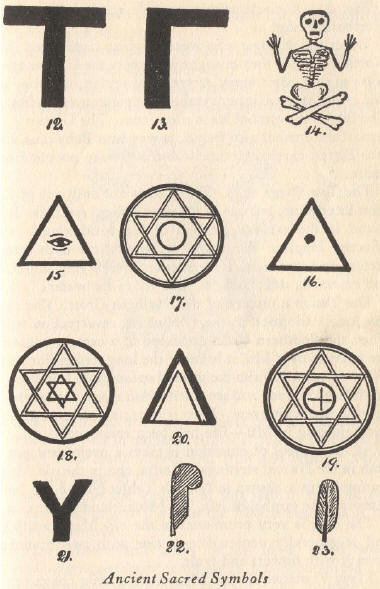
As the symbol of emersion it takes a prominent place both in the
Naacal writings of India, and in the old Mexican writings as shown
in Niven's Tablet No. 18. In both cases it is the symbol of Mu, the
Motherland's emersion.
The Tau is very prominent in the old Maya writings and is generally
depicted as a tree with two branches upon it with flowers and fruit
Maya Vignette
British Museum No. 9789
This vignette
comes from a Maya Manuscript which is in the British Museum, and
represents the rain arriving in Yucatan. The two figures are
allegorical, representing the divisions of Mayax.
Troano Manuscript
This depicts the return of the rainy
season in Mayax.
The Tau was a universal symbol. It is found in the writings of the
Hindus, Chinese, Chaldeans, Incas, Quiches, Egyptians and other
ancient peoples. It played an important part in ancient religions.
Altars in temples, on which were made offerings of fruit and
flowers, were built in the shape of the Tau.
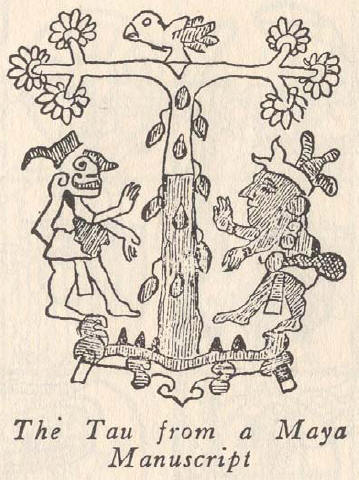
The name and the spelling of this symbol have never been changed. It
was T-a-u in the Motherland and it is T-a-u with us today.
In the Motherland every letter in a word was sounded: a was
pronounced dh and u was pronounced oo - the pronunciation therefore
is Ta-u. The Polynesians pronounce it correctly to this day.
The two-sided Square (Fig. 13, page 145). The two-sided square is
one of the most prominent symbols in Freemasonry and has an
exceedingly ancient origin, dating back to the time when early man
was first receiving religious instruction.
How long ago was that? I
cannot say, nor even guess.
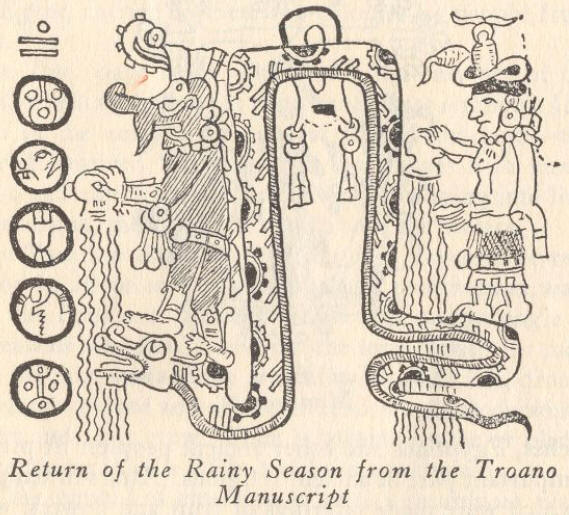
In two very old Naacal tablets, one of which is in India and the
other in Tibet, it is stated that man first appeared on earth in the
Land of Mu about 200,000 years ago, and in other Naacal writings it
would appear that his religious teaching was not long delayed after
his arrival; but, how long was long?
That cannot be estimated or
even guessed at; so that this point must remain an open question
until fate ordains that it shall be known.
But whichever way we look
at it, whether the period was a thousand years or tens of thousands
of years, the extreme antiquity of the two-sided square is clearly
shown; consequently, the great antiquity of what is now called
Freemasonry.
The two-sided square is the spelling of an ancient word meaning
Builder.
In the religious teachings the Great Primary Forces were often
referred to as the Builders - The Builders of the Universe and all
therein.
Among Niven's Mexican Stone Tablets there are hundreds where the
two-sided square appears in the writings.
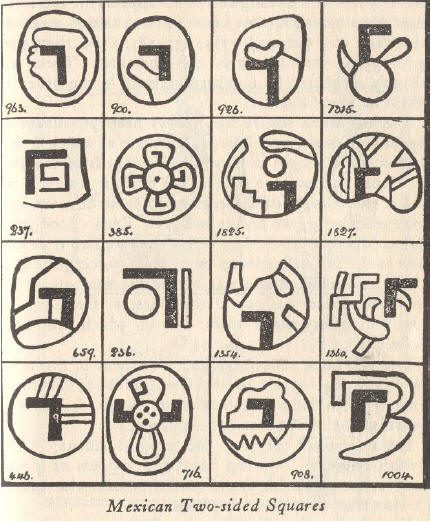
I am giving a plate of 16
of these tablets as examples, Nos. 963, 900, 925, 1315, 237, 385,
1825, 1827, 659, 236, 1354, 1360, 446, 716, 908 and 1004.
These are Niven's numbers; he numbered tablets in the order in which he found
them.
The two-sided square has always been prominent in Egyptian
Cosmogony. The earliest date at which I find the two-sided square in
Egyptian writings is of the time of Menes (about 5000 B.C.). Yet
here in America we find it exceedingly prominent 12,000 years or
more ago, 5000 years before we find it in Egypt. Even 12,000 years
ago in America, it was then very old, as we find it prominent in the
Naacal writings more than 50,000 years ago.
The two-sided square was one of the symbols of the god Ptah. Ptah
was one of the oldest of the Egyptian gods. Ptah has many titles,
one of which was "the builder."
The two-sided square became prominent in Egypt as the "Seal of
Osiris." In the Great Hall of Truth in Amenti when judging the souls
of the dead, Osiris is shown sitting on the two-sided square.
I am giving a cut from the papyrus Anana, in the British Museum,
showing Maat the goddess of Truth and Justice seated on the
two-sided square, also below, Osiris sitting on the two-sided
square.
The Ka
Fig. 14. This symbol, so well known to
Freemasons, is found on a cornice above the lintel to the entrance
of the Holy of Holies of the Temple of Sacred Mysteries at Uxmal. On
the cornice this symbol is many times repeated.
These emblems of mortality were used in the ancient religious
ceremonies to impress upon the adept what his end would be and to
fix firmly in his mind the necessity of living a life that would
bring no terrors when the soul released itself from the mortal to
pass into the world beyond.
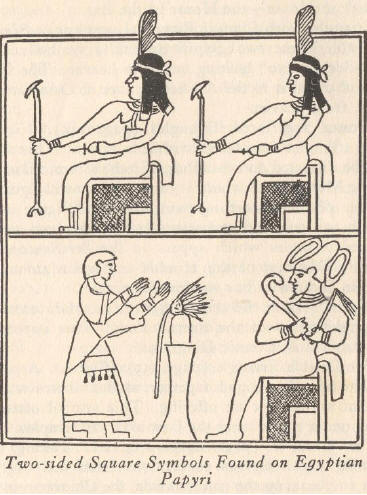
The Egyptian is a reflection of the Maya, so that from Egypt we can
get the original ceremonies.
In the Temple of the Great Pyramid
there was a sarcophagus with the emblems of mortality arranged
alongside it. The adept was placed in the sarcophagus that he might
contemplate these tokens of his earthly existence, and when he
emerged from it, a reminder was given him that after his soul left
the mortal body another life awaited him.
In the Quiche ritual a similar ceremony is gone through in the 7th
House - the House of the Bat.
Triangles with Central Figures
Figs. 15 and 16. These
two glyphs originally symbolized the "All-Seeing Eye" looking out
from heaven. The Egyptians changed it to the All-Seeing Eye of
Osiris looking down from heaven.
Crossed Interlaced Triangles
Fig. 17. Two triangles
interlaced within a circle. This figure will be dissected and
deciphered in the Cosmic Diagram of the Motherland, where it forms
the central figure.
Fig. 18. The startling point about this figure is that within two
outer crossed triangles there are two smaller crossed triangles
which appear in the Sri Santara, the Cosmic Diagram of the Hindus
and again among the Pueblo Indians of our southwestern states.
Fig. 19. Here the central figure is a plain cross, the original
symbol of the Sacred Four. This appears in the Babylonian Cosmic
Diagram.
The Double Triangle
Fig. 20. A pair of double triangles
bound together at their bases was the ancient symbol for an
offering. This symbol often appears under the arms of the Law altars
in temples.
The Great Y
Fig. 21. Taking their learning and religious
conceptions from the Uighurs, their forebears on the paternal side,
the Chinese replaced the equilateral triangle at the time of
Confucius with the figure Y.
This they called the "Great Term," the "Great Unite," the "Great Y."
"The Y has neither body nor shape, all that has a body and shape was
made by that which has no shape. The Great Term or the Great Unite
comprehends Three; One is three and three are one."
Feathers
From the beginning the feather has played an
important part in symbolisms.
The feather in the Motherland was the symbol for truth. It is also
prominent in Egyptian symbolizing the emblem of truth. It was always
colored blue in Egypt.
Fig. 22. Except in later times in Egypt, a straight feather was
always used in the crown of the King and the headdress of the High
Priest. A plume of three yellow feathers was worn in Mu, the
Motherland.
Fig. 23. The ostrich feather was used in Egypt, except on the heads
of their ancient gods, where the straight feather was retained.
The Eight Roads to Heaven
This is a page of symbols all
saying there are eight roads to heaven.
Each country and each people
seem to have had their own views as to the most appropriate way of
forming a symbol to express this conception. But Niven's old
Mexicans outdid them all. I find scores of tablets in his collection
with a figure symbolizing the Eight Roads to Heaven.
I have selected Tablets Nos. 1109, 277, 736, 405, 694, 295, 58 and
1111 as representative.
From the Hindu we learn that the eight roads to heaven consisted of
actions and thoughts in life, and were:
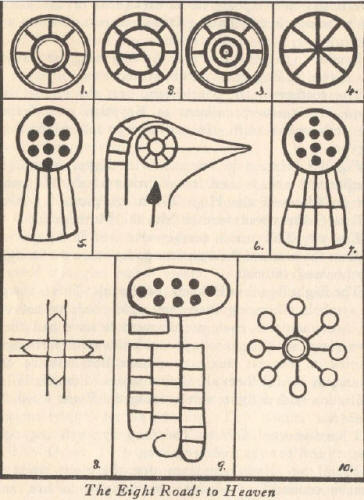
1. Right belief.
2. Right speech.
3. Right living.
4. Right thought
5. Right action.
6. Right exertions.
7. Right meditation.
8. Right adoration of God.
Pillars as sacred emblems are without doubt of extremely ancient
origin. It is my firm belief they date back to the first temple ever
erected for the worship of the Deity.
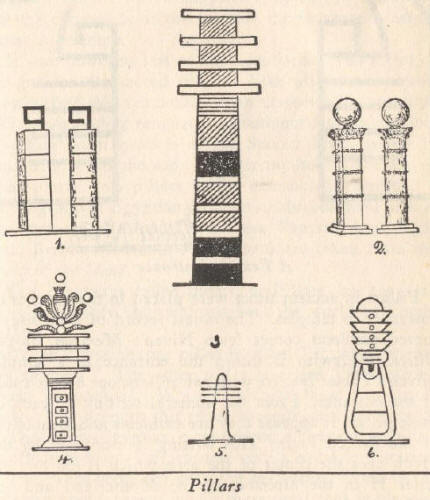
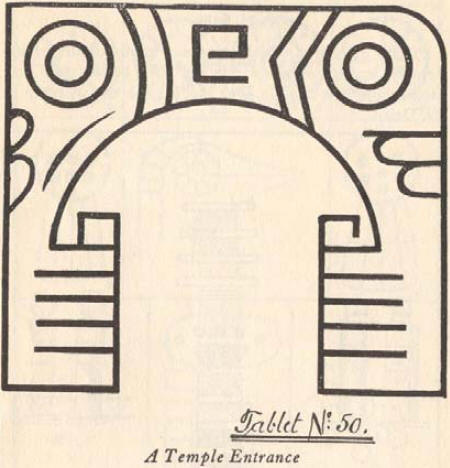
Pillars in ancient times were placed in the porches or entrances to
temples.
The oldest record of their use as sacred emblems comes from Niven's Mexican Buried Cities. Herewith is shown the entrance to a
temple, Niven's Tablet No. 50, with two pillars, one on each side of
the entrance. From the numeral writing on each of these pillars it
appears they are emblems and symbolical of the Sacred Four.
This
writing is confirmed by the glyph over the center of the arch which
is the hieratic letter H in the alphabet of the Motherland and the
alphabetical symbol of the Sacred Four. The ancient pillar was built
in four divisions, each division being a cube. These were capped
with symbols. On the left hand pillar a square is placed.
The square
was the ancient symbol for strength. The right-hand pillar was
capped with the glyph expressing completion, established, finished.
The origin of pillars as sacred emblems was the symbolizing of them
for the Four Great Primary. Forces, the commands of the Creator in
the beginning, and the two symbols which crown these pillars say
that by following out the commands of the Creator the universe is
established in strength.
It was, however, left to the Egyptians to run a riot of designs for
the sacred pillars.
Like all other symbols they carried this
symbolism to an extreme; but in all of their designs they retained a
prominent feature to show that they were symbols of the Sacred Four,
generally four bars across the top. In their mythology the Egyptians
placed two pillars at the entrance to Amenti. I give a group of
Egyptian pillars with the beautiful ones at the entrance to Amenti,
from the Papyrus Ani - 1500 B.C., British Museum. Nos. 3 to 6 are
taken from the Book of the Dead.
The Egyptians called them Tat Pillars, but they are more commonly
known throughout the world as Totem Pillars.
By the Egyptians one pillar is called Tat, which means "in
strength." The other pillar is called Tattu, which means to
establish.
When combined, these two words mean:
"In strength this
place is established for ever."
The Tat in Egyptian is considered a figure of stability. It also
represents four corners and is equal to a square.
Two Tats form the entrance to Tattu. Tattu is the gateway to the
region where the mortal soul is blended with an immortal spirit and,
"established in the mysteries of Amenti forever."
In the porch, or entrance, to King Solomon's Temple, two special
pillars were erected (I Kings 7:21, 22):
"And he set up the pillars
in the porch of the temple: and he set up the right pillar, and
called the name thereof Jachin: and he set up the left pillar and
called the name thereof Boaz."
In Hebrew the word jachin means "to establish," and the word boaz
means "in strength."
At the entrance to King Solomon's Temple and also at the entrance of
the Judgment Hall of Osiris two pillars were erected. In each case
the two pillars have identically the same name, language considered,
and with the identical meaning, also the ornamentations on the
pillars, down to the lily work, were identical, showing that King
Solomon made a complete copy of the pillars at the entrance to
Amenti for his own temple in Jerusalem.
Pillars are erected by the Maoris of New Zealand at the entrances to
their villages, and similar pillars are used by the American Indians
of the Northwest.
Plato informs us, speaking of Atlantis: "There the people gathered
every fifth year and sixth year alternately, and with sacrifice of
bulls, swore to observe the sacred inscriptions carved on the
pillars of the temple."
Java is one of the large islands of the Malay Archipelago, and in
writing of it, Forbes says:
"In Java is a tribe called Karangs, supposed to be descendants of
the aborigines of the island, whose old men and youths, four times a
year, repair secretly in procession to a sacred grove in a dense
forest, the old men to worship, the youths to see and learn the
mysteries of their forefathers. In this grove are the ruins of
terraces laid out in quadrilateral enclosures, the boundaries of
which are marked by blocks of stone, or fixed in the ground.
Here
and there on the terraces are conspicuous monuments - erect pillars,
and, especially noteworthy, a pillar erect within a square. Here
these despised and secluded people follow the rites and customs that
have been handed down to them through their forefathers from vastly
remote ages, repeating with superstitious awe a litany which they do
not understand or comprehend. This very litany is found in the
Egyptian Book of the Dead."
I have emphasized a pillar erect within
a square because that, too, is found in the Book of the Dead.
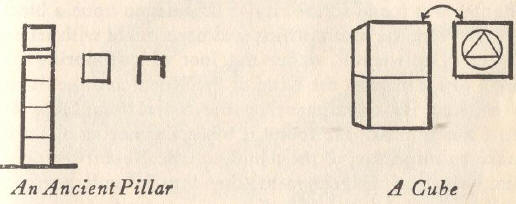
a. The Ancient Pillar. The first pillars that I have any record of
consisted of Four Cubes placed one on top of the other and capped
with symbols. The pillar on the left was square and had placed on
its top a square; the pillar on the right was round and had the
symbol Established. These pillars were symbolical of the Sacred Four
who Established in strength, law and order throughout the universe.1
1 The shape of these pillars is shown on the ground plan of one of
Niveo's Mexican temples (page 258).
b. The Cube. The Cube is of special interest to Royal Arch Masons.
An account of its finding is given in the Rubric of the 64th chapter
of the Book of the Dead.
Translation by Pierret (Turin Copy).
"This chapter was found out in Hermopolis on a brick of burnt clay, written in blue under the feet
of the god Thoth.
"The finding out, at the time of King Menkara, whose word is truth,
was made by Prince Har-titi-f in this place, when he was travelling
to inspect the temples. It related in itself a hymn which
transported him to ecstasy. He removed it to the King's chariot as
soon as he saw what was drawn on the cube: a great mystery."
Papyrus dated 3733 B.C. (London Copy).
"This chapter was found in
the city of Khemennu upon a block of iron from the south, which had
been inlaid with letters of real Lapis-lazuli, under the foot of god
during the reign of his majesty the King of the North and the South
Men Kau Ra triumphant by the Royal Son Heru-Ta Ta-f triumphant. He
found it when journeying about to make an inspection of the temples.
One Nekhit was with him, who was diligent in making him to
understand it, and he brought it to the King as a wonderful object,
when he saw that it was a thing of great mystery which had never
before been seen or looked upon."
Papyrus. Mes-em-neter. 4266 B.C.
(2)
"This chapter was found in the
foundation, on a plinth, of the shrine of the Divine Hennu boat by
the chief Mason in the time of the King of the North and the South,
Hesepti triumphant."
A Mexican Cube
Tablet No. 151 of Niven's collection. This stone
cube was found by William Niven, at Santiago Ahuizoctla, in amongst
scores of other stone tablets. Its surfaces are 10½ inches across.
2 The date given this papyrus seems doubtful.
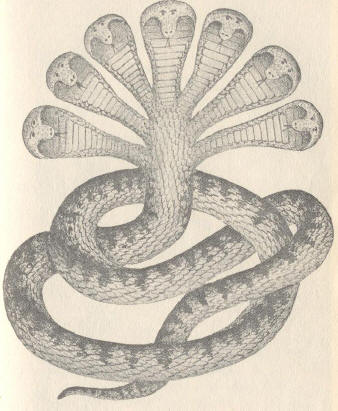
Narayana, the Seven-Headed Serpent, the Symbol of the Creator and
Creation.
-
Nara means Divine One
-
Yana - creator of all things
-
Naacals - seven superlative intellects
-
Vedanta - seven mental
planes
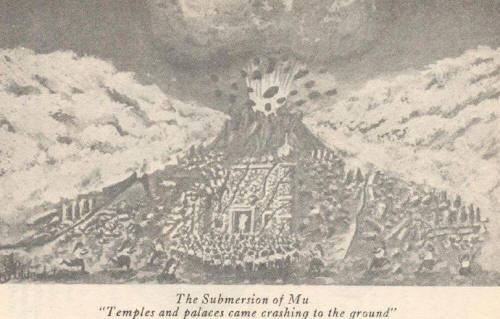
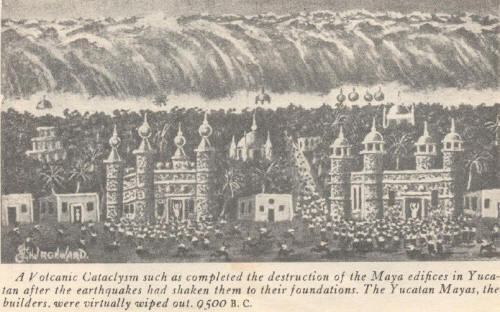
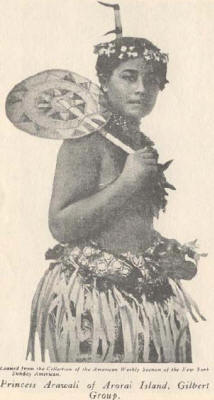 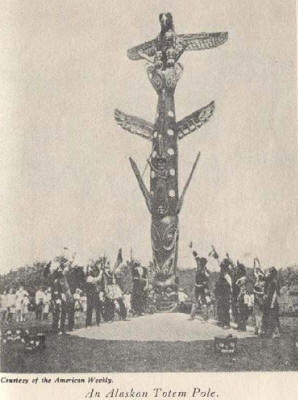
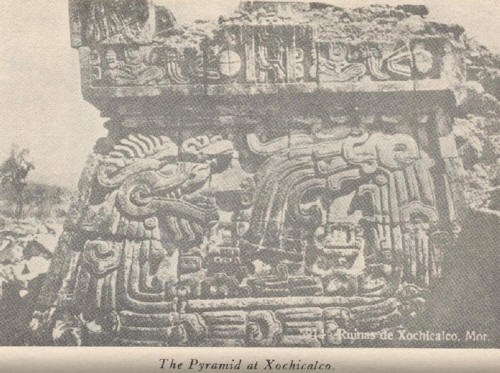
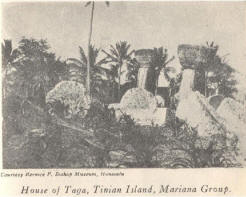 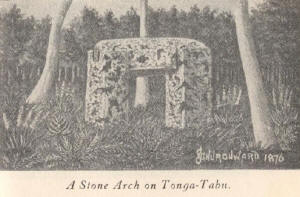
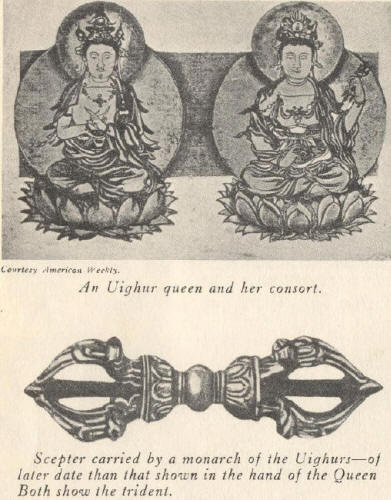 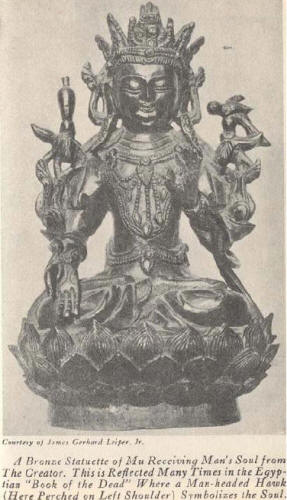
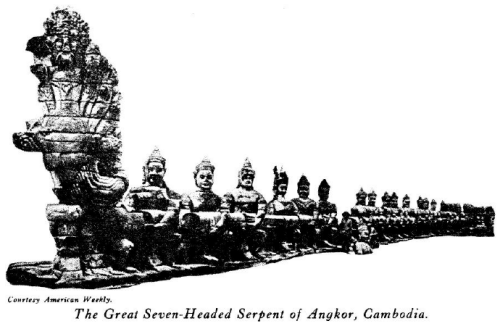
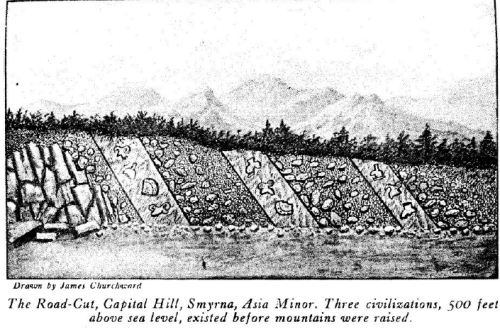
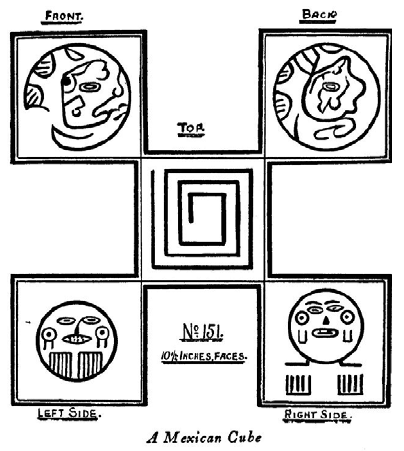
William Niven is a Mason of high degree; he called my particular
attention to this stone.
There is one great difference between this cube and the Egyptian.
The Egyptian shows the cube physically doubled. The symbol on the
top of this cube is the hieratic letter H quadrupled within itself.
This means one of two things, the quadrupling either forms an
adjective, emphasizing, or, it says physically quadrupled.
This last meaning appeals to me as the correct one, because, at the
time of these writings, when an adjective was used, although the
same letter it was a different glyph, as I have heretofore
explained.
Beyond this difference, the reading of the two cubes is |
essentially the same.
The Four Great Primary Forces
"The Sacred Four." Apparently, from
the beginning, the Four Great Primary Forces, called in the Naacal
writings the Sacred Four, have played a cardinal part in man's
religion. It would appear that most of the ancient theology was
based on their workings, and many theological lines and divergences
sprang from them.
They are not dead. They remain with us to this day, although, from
the start, their vestments have been changed from time to time and
theological trimmings constantly added.
In ancient times it was quite popular to dedicate temples to these
forces. In all of the plans of temples among Niven's Mexican Stone
Tablets I find that every one was dedicated to the Sacred Four as
representative of the almighty power of the Creator (symbolic of His
power).
The earliest symbol of the Sacred Four I found in the Naacal
writings of 70,000 years ago. It was a plain cross +. As time wore
on there were three developments of this original cross, ending in,
1. The Swastika
2. A form of the Maltese Cross and
3. The Winged Circle.
All crosses are symbols of the Sacred Four.
It seems not out of place, at this point, to give an explanation of
the Sacred Four, and to define clearly the difference between them
and the Seven Great Commands of Creation; because I find that some
of our Egyptologists have gravely erred concerning them. The Sacred
Four were the executors of the Seven Commands.
Tersely put, the Creator gave Seven Commands and the Sacred Four
carried them out.
The ancient conception was:
"In the beginning chaos reigned
throughout the universe, which was in darkness and without sound.
Then the Creator, desiring to create worlds, commanded His Four
Great Forces to establish law and order in the universe so that
creations might commence. When law and order became established the
Creations were carried out by the Sacred Four according to His
desires and commands."
This paragraph is from a very old Naacal
writing and is the identical cosmogony shown in the Mexican tablets,
proving clearly that the origin of the Mexican tablets is the same
as the Naacal, namely, the Sacred Inspired writings of Mu.
Apparently all ancient peoples had their special names for the
Sacred Four according to their language; some had scores of names
for them.
They were designated as:
A little later on I find them also called: The Four Great Pillars of
the Universe, the Four Genii, etc.
Still later:
-
the Amshaspands by the Mazdeans
-
the Elohim and Seraphs
by the Hebrews
-
the Rabiri and Titons in Hesiod's theogony
-
today they are: The Archangels of the Christians and Mohammedans
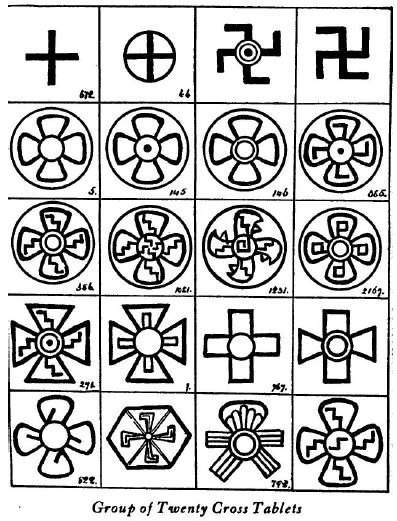
Not only did the Sacred Four get sundry names bestowed upon them by
various people; but symbols in the form of crosses were designed to
emphasize the names. Niven's old Mexicans ran an artistic riot in
these cross designs, many of which were very beautiful (I have over
100 of these designs).
The Swastika, however, always retained a warm
corner in their hearts.
Among many the winged circle became the favorite expression for the
Sacred Four. The Egyptians produced some wonderfully artistic and
beautiful designs of the winged circle.
I give here a plate including 20 of Niven's Mexican Stone Tablets
with crosses on them: also, the key for their reading.
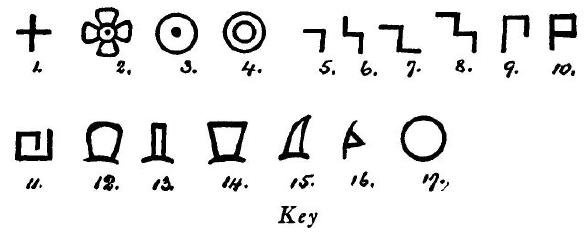
Key for the reading of Cross Symbols.
1. The first original for the
Sacred Four. A plain cross.
2. The oldest form of looped cross.
3. Circle with a dot in the center. The Southern or Naga symbol of
the Sun as Ra, the monotheistic symbol.
4. A double circle. The Northern or Uighur Symbol of the Sun as Ra.
The monotheistic symbol of the Deity.
5. Builder.
6. Architect.
7. Geometrician.
8. The Master Builder.
9. Established, erected.
10. Strength.
11. Hieratic letter H, the alphabetical Symbol of the Sacred Four.
12. Completed. The order has been carried out and has been
completed.
13. Pillar.
14. Heaven.
15. A Primary Force.
16. Active. A spear, arrow, javelin or dart.
17. A plain circle around the cross symbolizes the universe,
intimating that the forces are working throughout the universe. The
circle symbolizing the Universe was called Ul. Ul translated means -
the end of space. So that where this circle is used it refers to the
end of space, and includes the whole universe.
I have translated some glyphs as builder, architect and
geometrician, etc., because these words are equivalents for the Naga
names of these glyphs.
What the actual names were among these old
Mexicans in their own language I cannot tell. They had, however, a
language of their own, varying considerably from the Naga. The Naga
and Mexican symbols being the same, undoubtedly the meanings were
the same.
Names were given them to complete their Sacred Mysteries to hide
from the layman the fact that they were the Primary Forces.
Fortunately these Forces are so minutely explained in other tablets
that it becomes easy to give them modern names with their origins
and workings.3
3 Pythagoras on his return from Egypt taught that the numeral four
referred to the Great Creative Forces.
The Swastika
The Swastika, popularly called the "good luck
symbol" and one of the many symbols of the Four Great Primary
Forces, was a favorite symbol among the ancients throughout the
world and still clings to the hearts of present humanity.
It belongs to the group of Masonic symbols as much as any which they
use, and a great deal more so than many.
But the poor old Swastika has had its troubles. For a long time the
ancients would not let it stay put.
Let us see what it went through:
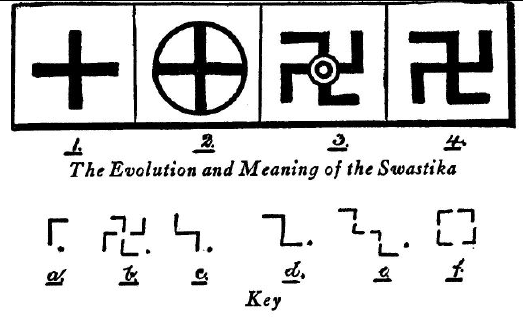
Fig. 1. Is the original figure for symbolizing the Four Great
Primary Forces.
Fig. 2. Is a change made, but at what date I cannot say. The circle
symbolizes the Creator, so the cross, being within the circle, makes
it imperative to include the Creator when speaking of the Four Great
Forces only. So a change was made.
Fig. 3. In this figure the ends of the cross are projected beyond
the circle, then bent over at right angles - pointing -west - with
the symbol of the Creator in the center. This did not meet the
requirements, for the Four Great Forces could not now be spoken of
without mentioning and including the Creator.
Fig. 4. In this figure the symbol of the Creator is removed, leaving
a compound glyph made up of the symbols of the Four Great Builders,
joined together in such a manner that they form a cross, called the
Swastika, in which form it has been retained to present time.
The esoteric or hidden meaning of the Swastika. The priesthood had a
meaning for this cross beyond that which they communicated to the
layman.
A. Is the glyph reading Builder.
B. The cross split open showing the Four Builders.
C. Is the glyph reading Geometrician.
D. Is the glyph reading Architect.
E. Reads The three steps to the throne.
F. Shows the Four builders forming a square.
This not only reads the Four Great Builders but the Four Great
Strong Ones. It is also the original symbol for the earth, which is
the four-sided square.
Legend
At the command of the Creator the Four Great Primary Forces
built the universe and all therein. They - the Four Great Builders,
the Heavenly Architects and Geometricians, the Four Great Strong
Ones - built the earth and formed its life.
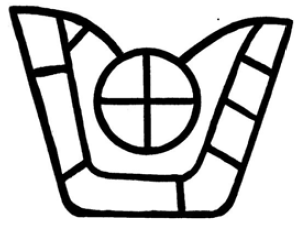
The butterfly winged circle. Niven't Mexican Stone Tablet No. 66.
The oldest-known winged circle - probably the mother of all winged
circles - date over 10,000 B.C.
The Winged Circle
The Winged Circle is one of the last, if not the
very last, design for symbolizing the Four Great Primary Forces;
unless we include our present-day conception, which is the
Archangel, represented to us as a human form with wings and trumpet.
All of the wings on the following circles arc feathered.

The oldest of the Feather Winged Circles. (Naacal)
The oldest example of a winged circle with feathers I found in a
venerable Hindu manuscript. The manuscript was a copy of some sacred
writings. So that the age is unknown.
It consisted of the second
figure shown in the evolution of the Swastika with a pair of
feathered brings.

Guatemalan
Out of the 2600 tablets found by Niven in Mexico, there is only one
winged circle, and this one is totally unlike any of the others. All
the others have wings feathered like a bird.
This Mexican example
has butterfly wings.
Legends
To find the winged circle at its most prosperous era we
must come down to the time of the Assyrians, Babylonians and
Egyptians, from 3000 B.C. down to 1000 B.C.
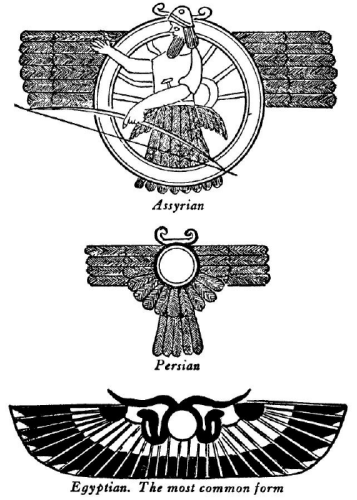
A winged circle painted on the end wall of the funeral chamber of
Queen Hatshepsut. She it was who when princess of Egypt pulled Moses
out of the bullrushes.
The curved form implies exceptional
protection.
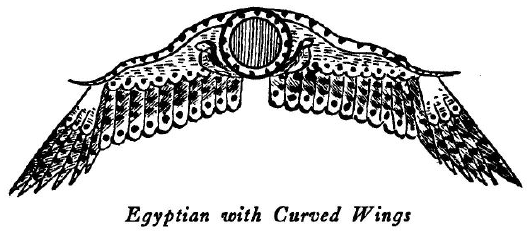
Another one of unknown date was sent to me as coming from Greece.
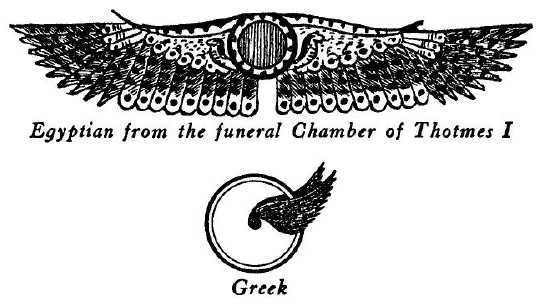
Back to Contents
|































